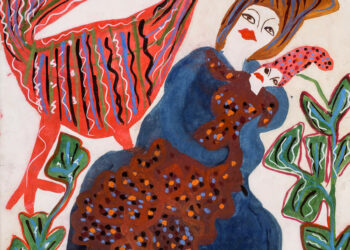Experience vibrant works by a daring artist who traveled the world.

Pacita Abad with her trapunto painting Ati-Atihan, 1983, wearing garments and jewelry collected on her travels; courtesy Pacita Abad Art Estate
The first retrospective of Pacita Abad (born 1946, Basco, Philippines; died 2004, Singapore) features more than 40 works including her signature trapunto paintings: stuffed, quilted canvases Abad adorned with materials and methods she investigated during her lifetime. Over a 32-year career, the prolific artist made a vast number of artworks that traverse a diversity of subjects – from colourful masks to intricately constructed underwater scenes to abstract compositions – revealing visual, material, and conceptual concerns that still resonate today.
When Abad left Manila in 1970, she stopped to visit her aunt in San Francisco where she found a city thrumming with radical political and creative activity. This context of Bay Area progressivism formed the crucible of her growing engagement with art, and her extensive world travels, beginning in 1973, solidified her commitment. Abad, who became a U.S. citizen in 1994, spent time in more than 60 countries across six continents, including Sudan, Bangladesh, Thailand, and Afghanistan, with longer stays in the Philippines, Indonesia, and Singapore. Through her travels, she interacted with myriad artistic communities, incorporating diverse cultural traditions – from Korean ink brush painting to Indonesian batik – into her expansive practice. The portability of these works and use of textiles Abad collected on her travels further reflected her peripatetic existence.
Abad’s embrace of quilting and other kinds of needlework confounded critics, who dismissed her works as naïve, childlike, and ethnic. In fact, Abad’s multifaceted practice articulated a powerful material politics, reflecting her vision of a nonhierarchical world. This exhibition celebrates Abad’s bold self-determination, commitment to social justice, and radical artistic experimentation.
Born in the Philippines to a family of politicians, Abad was greatly influenced by her family’s public service. In 1970, after leading a student demonstration against the Marcos regime, Abad left the Philippines. She intended to move to Madrid to finish a degree in law, but a stop in San Francisco to visit relatives became a long-term stay that would change the trajectory of her life.
1970s San Francisco was a hub of counterculture and social movements and, for Abad, a formative place of creative origin. Here, she met Asian and Latin American immigrants who had left their home countries for economic or sociopolitical reasons. Their stories initially inspired her to pursue studies in immigration law so that she could advocate for their causes. At the same time, Abad immersed herself in the local art scene and fell in love with art as a master’s student in history at Lone Mountain College (now part of the University of San Francisco) after working as the school’s Coordinator of Cultural Affairs. Though Abad received a scholarship to attend law school at UC Berkeley following her master’s degree, the artist chose to forgo her acceptance for travel and research. Art soon became the conduit and catalyst through which she advocated for marginalised people.
Abad became a prolific artist, and her choice of unstretched canvases as her primary medium gave her mobility as she traveled to and lived in over 60 countries with her husband, Jack Garrity, who worked as a development economist for international organisations. Her travels had an enormous impact on her practice as far as forms, materials, motivations, and visual traditions she’d learned about, from sewing and stitching techniques from Rabari women in Rajasthan to mirror embroidery in India.
The exhibition will be on view from the 21st of October, 2023, until the 28th of January, 2024. For more information, please visit SFMOMA.



